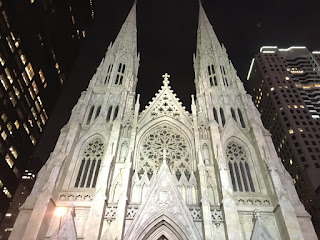While walking down Fifth Avenue, it would be hard to miss the
towering, neo-gothic styled cathedral beside you. Its’ elaborate architectural
details are truly admirable and striking; you may find a man of any religion
may stop and gaze at its beauty. As you open the doors, you soon gather that
inside is especially majestic. You are surrounded by tranquility inside the
churches’ walls, a stark change from the hectic outside world. Thousands of
religious icons and symbols enhance its’ true beauty. Today, New Yorkers and
visitors are fortunate enough to gather in a place where people of all
backgrounds come together to retreat from outside world.
In the eighteenth century, only a few
hundred Catholics resided in New York City. The Catholic population began to
increase, and an urban revolution was occurring. During urban revolutions in
Europe, large and influential cathedrals were built, and America followed suit.
At this time, the diocese of New York and New Jersey were established, and
people became involved in the construction of a new church. Many poor Irish
Catholic immigrants lived in New York City and as a result, the church was
named after the patron St. Patrick. St. Patrick’s Cathedral was built in 1809
and soon became a staple of New York City. More than five million visitors come
through St. Patrick’s Cathedral each year.
St. Patrick’s Cathedral is known as a
symbol for American religious freedom. America was seen as a novelty, and a
land of opportunity. Irish immigrants came to America in masses and looked to
find a better life. They were extremely impoverished, out of work, and lived
with their families on very little. St. Patrick’s Cathedral became a place for
the congregation of Irish Catholics. Soon after, the church brought together
Catholics of other ethnicities, which provided many with their spiritual needs.
People began imagining the “new America” in different ways and associated it
with being multicultural and multi religious.
If you asked a group of people in a room to define the term
“religious”, your responses would certainly vary. Many in this group, however,
may say that taking part in religion is a way to get involved with society. For
example, some Roman Catholics attend mass every Sunday. Others may attend mass
every day, and some may attend on Christmas and Easter. But, who is to define
what “religious” truly is? The sense of unity in St. Patrick’s Cathedral
allowed Irish Catholics of all religious standings to come together. In
Ireland, they felt a sense of betrayal in many senses and came to America for
something new. Many were simply born Catholics, but didn’t practice, attend
mass, or even receive communion. This sense of community allowed them to feel a
strong connection to the church. Although they didn’t always attend mass
regularly, when they did, they felt they were able maintain their Irish
identity. Once other ethnic groups integrated into St. Patrick’s Cathedral, the
Irish slowly integrated into the new multicultural society.
The cathedral itself is a religious text, and it carries infinite
meanings; as a text can be interpreted in many ways. This can vary from a piece
of furniture, place of religious worship, a magazine, or a work of art. Since
we all come from different ethnicities, cultural backgrounds, and histories, we
find that we construe these types of objects differently. The Irish, for
example, saw it as a center for Irish life in New York. “The oldest Roman Catholic Church building in New York
City, it played vital social and political roles in the lives of young
immigrants, helping them adapt to their new home” (Lower East Side Tenement
Museum, 2005). Pope Francis’ visit in the fall demonstrates how significant St. Patrick’s Cathedral is on Catholic lives today.
"Lower
East Side Tenement Museum." Lower East Side Tenement Museum. 2005.
Web. 21 Apr. 2016.

No comments:
Post a Comment